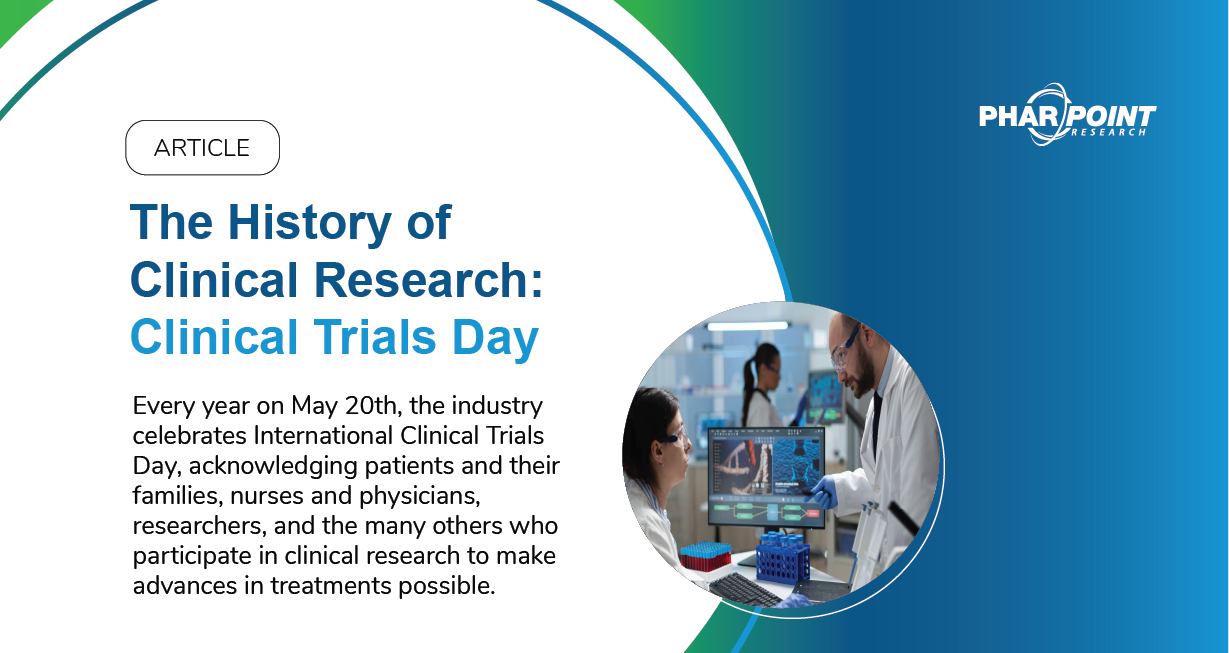Celebrating Clinical Trials Day: The Evolution of Clinical Research
Every year on May 20th, the industry celebrates International Clinical Trials Day, acknowledging patients and their families, nurses and physicians, researchers, and the many others who participate in clinical research to make advances in treatments possible.
The History of Clinical Research
The First Recorded Controlled Trial: Dr. James Lind

Lind, while working as a surgeon on a ship in the British Royal Navy, noticed the high mortality rate of scurvy among sailors. In an attempt to find a more effective method for treating the disease, Lind designed a comparative trial. The trial included various treatment plans for 12 different sailors affected by scurvy.
In his in-depth recordings of the trial, he explained, “Their cases were as similar as I could have them… they lay together in one place… and had one diet common to them all.”
After his trial, Lind noted that the “most sudden and visible good effects” were seen in patients who consumed oranges and lemons in addition to their common diets.
The Introduction of Placebo
While Lind’s study may have paved the way for controlled trials, it took nearly 150 more years for the placebo to be introduced.
In 1863, US physician Austin Flint planned a clinical study that compared a “dummy” treatment to an active one. His study, which included 13 patients with rheumatism, gave subjects an herbal extract as opposed to the established remedy for rheumatism.
Flint would later describe the treatment as a “placeboic remedy.”
Clinical trials of the 1940s: Introducing Randomization and the Double-Blind approach
In the early-to-mid 1940s, modern approaches to clinical research came to fruition.
In 1943, a British group carried out the first double blind controlled trial while investigating a treatment for the common cold. (Unfortunately, the analysis of trial data did not show any protective effect.)
Three years later in 1946, the first randomized controlled trial took place. The study, conducted in the UK, used a meticulous design and implementation plan to analyze the effect of streptomycin in pulmonary tuberculosis.
The Introduction and Evolution of Contract Research Organizations
The first CRO-like companies were established in the 1940s and 1950s. These companies typically provided animals for clients to run tests on or conducted animal testing themselves. They weren’t just limited to pharmaceuticals – the “original CROs” worked with clients in a range of scientific areas.
As regulation increased for pharmaceutical products in the 1960s, however, offering preclinical testing of toxicology services for pharmaceutical companies became popular.
In the late 1970s and 1980s, new players were introduced, and the industry as it is today began to emerge. Companies like Quintiles (now IQVIA), Parexel, and PPD began. In addition to the traditional preclinical testing role, companies began offering services such as clinical trials, logistics, statistics, data management, and other functions.
The Rapid Growth and Expansion of CROs
By the late 80s and 90s, the industry was very rapidly developing.
In the 1980s, blockbuster drugs such as the first statin and the SSRI Prozac were approved – and costs in the industry were quickly rising.
Between the 1990s and the mid 2000s, CRO services increased from 4% of R&D spend to nearly 50%. A flood of mergers and acquisitions began. Some CROs began offering outsourcing for areas like drug discovery and medical marketing.
The relationships between CROs and pharmaceutical companies also began changing.
“If a drug company wanted,” an article by Robin Walsh on pharmaphorum describes, “it could do no work of its own at all, outsourcing the entire process to CROs.”
The CRO Industry Today & Beyond
As of 2021, reports have stated that the global CRO industry is expected to reach over $64 billion by 2027. It also continues to be marked by a number of mergers and acquisitions (such as ICON plc’s $12 billion acquisition of PRA Health Sciences in late February 2021).
The COVID-19 pandemic has certainly had an effect on the CRO industry. For one, it has accelerated the adoption of trial decentralization. According to an Oracle study, 76% of survey respondents had stated that the pandemic had accelerated their adoption of decentralized clinical trials (DCT).
Resources
This article was written with sources from:
https://www.ncbi.nlm.nih.gov/pmc/articles/PMC3149409/
https://pharmaphorum.com/views-and-analysis/a_history_of_contract_research_organisations_cros/
About PharPoint Research
PharPoint Research is an award-winning contract research organization (CRO) that offers clinical operations and project management, biostatistics and statistical programming, and data management services to innovative clients of all sizes.
PharPoint has supported trials across rare disease, oncology, CNS, infectious disease, and many other therapeutic areas with a 95% repeat business rate.
To learn more about how PharPoint Research can support your upcoming or current study, reach out to a representative.





